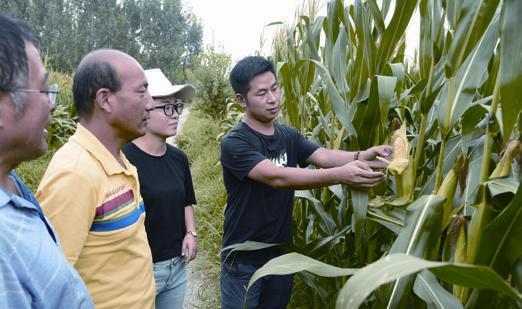All About Food
2019-11-05ByYuanYuan
By Yuan Yuan

With the release of its second white paper on food security on October 14, China showed, with pride, the great progress it has made in the fi eld since 1996, the year its first such report was issued.
“Over 20 years ago, there were doubts in the international community about how China could feed its people. Now we have proven to them that we can realize food security by ourselves,” said Zhang Wufeng, head of the National Food and Strategic Reserves Administration, at a press conference on October 14.
Despite a weak agricultural foundation and extreme poverty, the Communist Party of China (CPC) has led an unremitting campaign over the past 70 years that has made China basically self-suffi cient in food supply, said the white paper titled Food Security in China.
China successfully feeds nearly 20 percent of the worlds total population with just 9 percent of the worlds farmland and 6 percent of the worlds total freshwater resources, Zhang said, adding that the country has made fundamental changes over the past seven decades, but food security has remained a matter of utmost importance.
“By feeding its nearly 1.4 billion people properly, China has greatly improved peoples nutrition and life quality, and its food security is a success of worldwide signifi cance,”the white paper said.
The progress
In the past decades, China has made remarkable progress in enhancing food security without undermining the food security of any other country in the world, said Li Guoxiang, a researcher with the Chinese Academy of Social Sciences.
“In the past 20 years, Chinas grain production capacity has increased from over 500 million tons to over 650 million tons, which shows a steady increase in grain security,” Li said.
China has placed great importance on sustainable development in food production and implemented a complete and special protection system for permanent basic farmland, said Jiang Changyun, a researcher with the Chinese Academy of Macroeconomic Research. For example, it has established functional areas for grain production and protected areas for important agricultural products.
Figures from the white paper showed that the country has 134.88 million hectares of cultivated land, an increase of more than 4.8 million hectares since 1996.
Innovation is the major driving force behind the enhancement of Chinas food security, Jiang said, as new agricultural technology has been adopted to increase farmland productivity.
In 2018, the Chinese Government started a seven-year automated agriculture pilot project, under which rice transplanters, pesticide applicators, fertilization equipment and driverless tractors navigated via global positioning satellites are used in Xinghua City, east Chinas Jiangsu Province.
To protect cultivated land, the country has implemented an overall plan, strictly controlling the use of cultivated land and balancing the use and replenishment of arable land, the white paper said.
Since the 18th National Congress of the Communist Party of China (CPC) in 2012, the Party has implemented a national food security strategy. Through supply-side structural reform and institutional innovation, China has raised grain productivity, modernized grain circulation, improved food supply structure and achieved steady development of the grain industry.
“China has rolled out a series of policies to motivate farmers. It has eliminated agricultural taxes and reduced the burden on farmers by over 130 billion yuan($18.3 billion) per year,” said Su Wei, Deputy Secretary General of the National Development and Reform Commission.

Currently, Chinas per-capita food output is about 470 kg, an increase of 14 percent from 414 kg in 1996, and 126 percent from 209 kg in 1949, according to the white paper. Since 2015, the total grain output in China has exceeded 650 million tons for four consecutive years.
The paper also noted that in the medium to long term, Chinas grain production and demand will remain tightly balanced, which means it must not slacken its efforts to ensure food security. By 2022, the country will complete the construction of 66.67 million hectares of high-standard farmland, and by 2035, its grain planting area will be generally stable.
Grain reserves and emergency response systems have also been improving as the government maintains suffi cient and quality food reserves in secured storage. Emergency food reserves for 10-15 days are available in large and medium-sized cities and areas prone to price fl uctuations.
Lai Yinghui, Director of the Grain and Material Reserve Bureau in southeast Chinas Fujian Province, where the acreage of arable land is just one third of the average level among provincial-level regions in China, said throughout the province, there are now 166 emergency grain processing enterprises and 1,466 emergency supply outlets. In addition, the provincial govern- ment has improved its emergency supply plan and strengthened emergency drills to ensure the availability of supplies at critical moments.
International cooperation
China has expanded international cooperation in food and agriculture and actively participated in global food security governance, making an important contribution to the healthy development of the world food industry and food security.
“In recent years, with rice and wheat output meeting domestic needs, China is fully self-sufficient in food supply, and the main driver of food imports and exports is to satisfy the need for variety,” the white paper said,“The Chinese people have more choices in what they eat and a healthier diet.”
Zhang Lubiao, Director of the Agricultural Trade Promotion Center under the Ministry of Agriculture and Rural Affairs, said the Chinese food market is more open than ever, with foreign-funded enterprises becoming a key force in the food industry.
These enterprises are penetrating deeper in the market, with growing market shares in edible vegetable oil and food processing, and their activities span grain procurement, wholesale and retail, and staple food supply.
Restrictions on foreign investment in agriculture have been further eased, allowing foreign-invested seed companies to operate in all grain types except for wheat, corn, rare species, species unique to China or genetically modifi ed crops.
While ensuring domestic food security, China has joined the global fight against hunger. The world is still facing severe food security challenges, with over 800 million people suffering from hunger, and international food trade faces more uncertainty due to disruptions from protectionism and unilateralism, according to the white paper.
Under these circumstances, China will continue to assist other developing countries to the best of its ability, further enhance grain trade cooperation with other countries participating in the Belt and Road Initiative to establish a new international platform and facilitate free and orderly fl ow of agricultural resources and the deep integration of markets in Belt and Road participating countries.
“China has been intensifying international cooperation in food and agriculture with other countries, and will continue to work with the international community to contribute to improved global food security,” Zhang Lubiao said.
